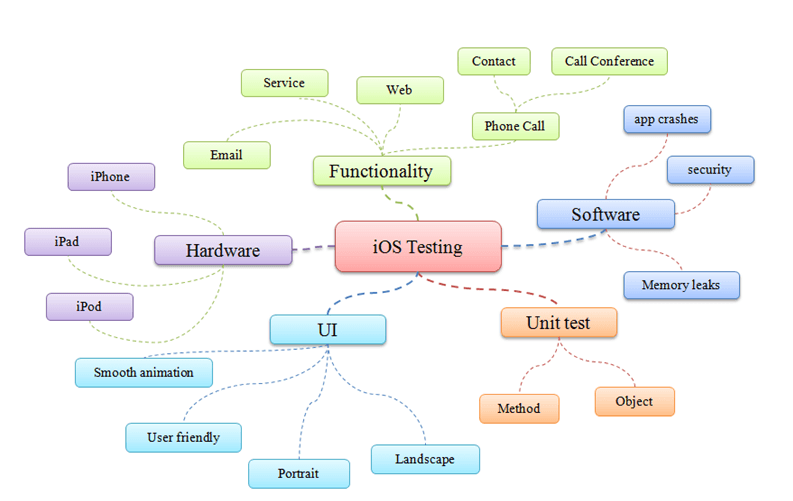
What is iOS App Testing?
iOS app testing refers to the process of evaluating and verifying the functionality, performance, usability, security, and compatibility of iOS applications. It involves conducting various tests to ensure that the app meets quality standards, functions as intended, and delivers a positive user experience on iOS devices.
Why iOS App Testing?

iOS app testing is essential for several reasons:
- Ensuring Quality: Testing helps ensure that iOS apps meet quality standards and perform as expected, providing a positive user experience. It helps identify and address bugs, glitches, and usability issues before the app is released to users.
- Bug Detection and Fixing: Testing helps detect and fix bugs and issues in the app’s functionality, user interface, performance, and security. Identifying and addressing these issues early in the development process reduces the likelihood of encountering critical issues post-release.
- User Satisfaction: Thorough testing helps ensure that iOS apps are reliable, stable, and user-friendly. By delivering a high-quality app, developers can enhance user satisfaction, retention, and engagement, leading to positive reviews, ratings, and recommendations.
- Compatibility Across Devices and Versions: Testing ensures that iOS apps function correctly across different devices (iPhone, iPad, iPod Touch) and iOS versions. It helps identify compatibility issues, layout inconsistencies, and device-specific bugs, ensuring a consistent experience for all users.
- Compliance with Guidelines: Testing ensures that iOS apps comply with Apple’s App Store guidelines, including design standards, performance requirements, security protocols, and privacy policies. Compliance with these guidelines is necessary for app approval and distribution on the App Store.
- Optimizing Performance: Performance testing helps optimize the app’s speed, responsiveness, memory usage, and battery consumption. By identifying performance bottlenecks and optimization opportunities, developers can enhance the app’s efficiency and user experience.
- Security and Privacy: Testing helps identify and mitigate security vulnerabilities, data breaches, and privacy risks in iOS apps. By implementing robust security measures and encryption protocols, developers can protect user data and enhance trust in the app.
- Maximizing ROI: Investing in testing early in the development process helps reduce the cost of fixing bugs and issues later. By delivering a high-quality app that meets user expectations, developers can maximize return on investment (ROI) and achieve long-term success in the competitive app market.
iOS testing MindMap

As shown in the above figure, iOS Testing MindMap shows all the items which tester should consider when conduct testing on iOS.
Manual Testing:
- Installation and Setup: Begin by installing the iOS app on a physical device or simulator. Ensure that the device is properly configured with the necessary settings and permissions.
- Functional Testing: Test the app’s basic functionalities such as navigation, buttons, forms, inputs, etc. Make sure that all features are working as expected according to the app’s requirements.
- UI/UX Testing: Check the user interface for consistency, responsiveness, and adherence to design guidelines. Verify that UI elements are correctly positioned, styled, and sized across different device sizes and orientations.
- Compatibility Testing: Test the app on various iOS versions, devices, and screen resolutions to ensure compatibility and responsiveness.
- Performance Testing: Evaluate the app’s performance by measuring factors like loading times, responsiveness to user inputs, memory usage, and battery consumption. Identify any performance bottlenecks or areas for optimization.
- Localization and Internationalization Testing: Verify that the app functions correctly in different languages and regions. Test for proper text alignment, formatting, and content translation.
- Security Testing: Assess the app’s security measures by checking for vulnerabilities such as data encryption, secure authentication, session management, and protection against common threats like injection attacks and data leakage.
- Accessibility Testing: Ensure that the app is accessible to users with disabilities by testing features like VoiceOver, dynamic text resizing, color contrast, and support for assistive technologies.
Automation Testing:
- Selecting an Automation Framework: Choose an automation framework compatible with iOS app testing, such as Appium, XCTest, or EarlGrey.
- Setting up Test Environment: Install the necessary dependencies and configure the automation environment, including SDKs, drivers, and IDEs.
- Writing Test Scripts: Create test scripts to automate common test scenarios, including navigation flows, input validations, and functional tests. Use the chosen automation framework to interact with UI elements and perform actions on the app.
- Parameterized Testing: Implement parameterized testing to execute the same test cases with different input data, allowing for more extensive test coverage.
- Continuous Integration (CI): Integrate automated tests into a CI/CD pipeline to enable regular testing and rapid feedback. Use tools like Jenkins, Travis CI, or CircleCI for automation and scheduling of test runs.
- Test Reporting and Analysis: Implement reporting mechanisms to generate detailed test reports with information on test results, execution times, and error logs. Analyze these reports to identify bugs and areas for improvement.
- Parallel Testing: Execute tests in parallel across multiple devices or simulators to reduce testing time and increase efficiency. Use cloud-based testing services like AWS Device Farm or Sauce Labs for parallel execution on real devices.
- Regression Testing: Automate regression test suites to verify that new updates or changes do not introduce regressions or break existing functionality.
By following this tutorial, you can ensure thorough testing of your iOS app using a combination of manual and automation techniques, leading to improved quality, reliability, and user satisfaction.



